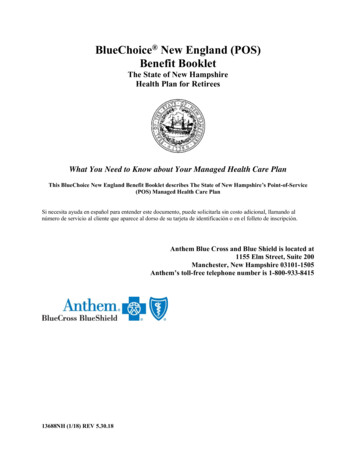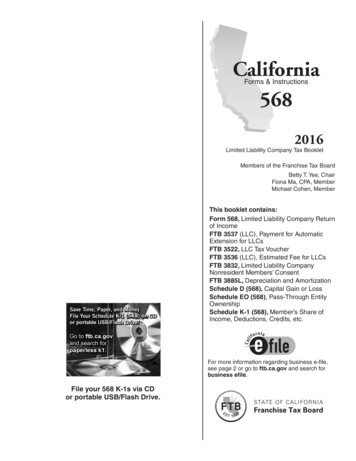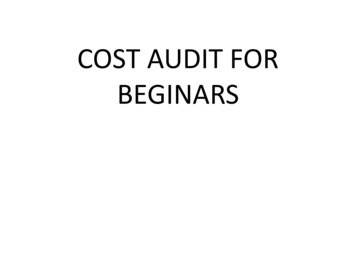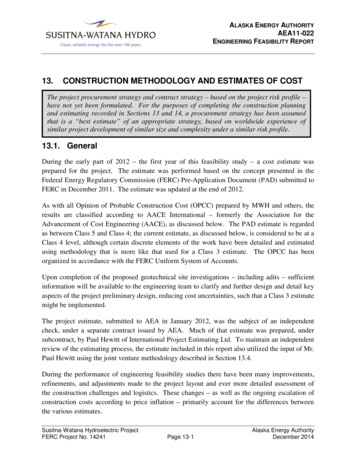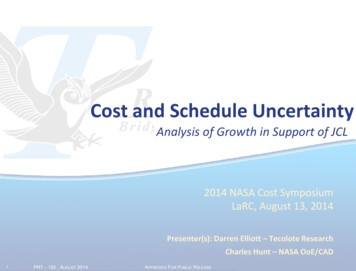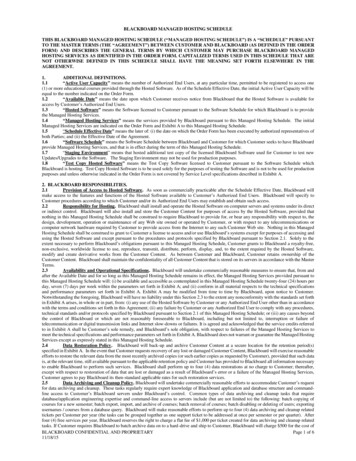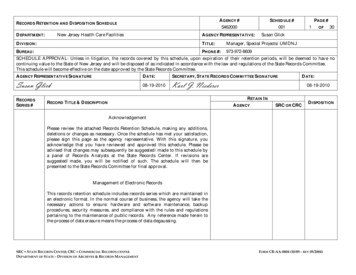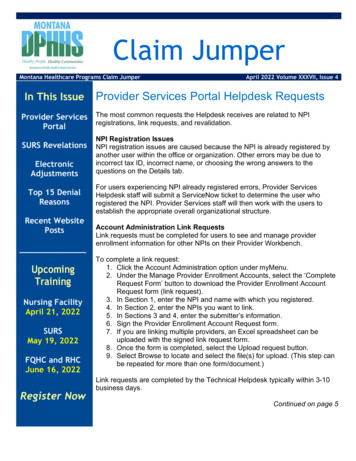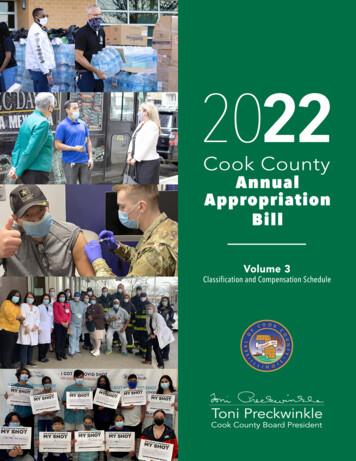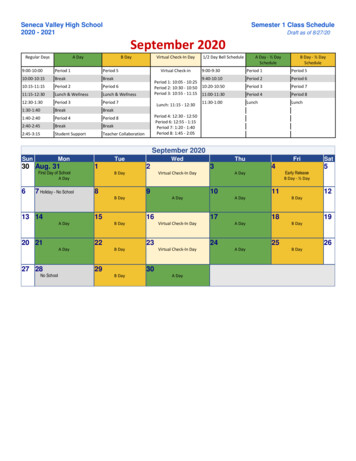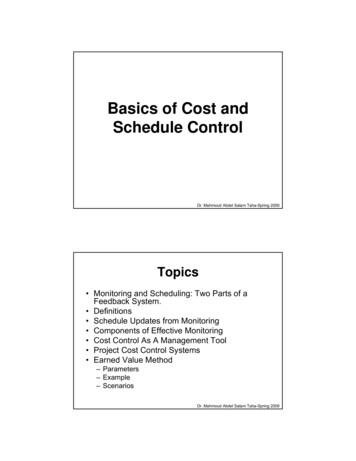
Transcription
Basics of Cost andSchedule ControlDr. Mahmoud Abdel Salam Taha-Spring 2009Topics Monitoring and Scheduling: Two Parts of aFeedback System. Definitions Schedule Updates from Monitoring Components of Effective Monitoring Cost Control As A Management Tool Project Cost Control Systems Earned Value Method– Parameters– Example– ScenariosDr. Mahmoud Abdel Salam Taha-Spring 2009
Monitoring and Control:Two Parts of a Feedback System Goal is to detect and correct deviation fromdesired– Budget– Schedule– Quality Detection: Monitoring Correction: Control– Much harder than monitoring!!– Bring project performance back in line with plans– Typical: Bring plans in line with performanceDr. Mahmoud Abdel Salam Taha-Spring 2009Growing Expenditures, DecliningControlDr. Mahmoud Abdel Salam Taha-Spring 2009
Definitions Project Monitoring is the set ofprocedures and management practicesused to collect information about theperformance achieved or forecasted in aproject, based on a set of performancemetrics. Performance Analysis: The process ofdetermining performance variances basedon monitored or forecasted performance.Dr. Mahmoud Abdel Salam Taha-Spring 2009Definitions Project Control: is the establishment of a system to measurereport, and forecast deviations in the project scope, budget, andschedule. The purpose of project control is to adjust the project to meet itsgoals by assessing the performance of the project, analyzingthe causes of performance problems, designing changes toaddress problems that are determined to need attentions andimplementing those changes through control actions. Project control is distinguished from project planning in twoImportant ways: 1) project control yields a set of designs,decisions, and actions, whereas project planning yields adesign and 2) project control is a real time process during theimplementation Not before the implementation begins.Dr. Mahmoud Abdel Salam Taha-Spring 2009
Schedule Updates fromMonitoring New estimates for activity– Costs– Durations– Resource availability New critical path– May lead to changed monitoring priorities NB: A schedule that does not get updated toreflect in--field conditions is– Unlikely to be used– Dangerous if usedDr. Mahmoud Abdel Salam Taha-Spring 2009Components of EffectiveMonitoring Representative Performance Metrics(established at planning phase) Cost & Schedule Milestones should be well-defined and defined and clearlyapproved/rejected. Reporting Schedule (perhaps of variableΔt’s)– Financial importance of activity– Activity criticality Rate of work– Rate of work– Difficulty of workDr. Mahmoud Abdel Salam Taha-Spring 2009
Components of EffectiveMonitoring (Cont’d) Management Scheme organized for honestlyand accurately identifying and reportingperformance Involvement of responsible andknowledgeable people in the reportingscheme Project Reviews (walkthrough’s &inspections) Project AuditsDr. Mahmoud Abdel Salam Taha-Spring 2009COST CONTROL AS AMANAGEMENT TOOL The early detection of actual or potentialcost overruns in field construction activitiesis vital to management. It provides the opportunity to initiateremedial action and increases the chanceof eliminating such overruns or minimizingtheir impact. Cost overruns increase project costs anddiminish profitsDr. Mahmoud Abdel Salam Taha-Spring 2009
PROJECT COST CONTROL SYSTEMS1.2.3.4.5.Charts of AccountsProject Cost PlanData CollectionData ReportingDecisionDr. Mahmoud Abdel Salam Taha-Spring 2009COST ACCOUNTS The first step in establishing, a cost controlsystem for a construction job is the definition ofproject-level cost centers. Their primary function is to divide the totalproject into significant control units, eachconsisting of a given type of work that can bemeasured in the field. See Fig 15.2 Textbook page 254.Dr. Mahmoud Abdel Salam Taha-Spring 2009
Cost Coding Systems A variety of cost coding systems exist inpractice, and standard charts of accountsare published by organizations such as theAmerican Road Builders Association,Associated General Contractors, and theConstruction Specifications Institute. Table 15.1 Textbook page 255 (UCI) Fig 15.3 Textbook page 256.Dr. Mahmoud Abdel Salam Taha-Spring 2009PROJECT COST CODESTRUCTUREExample from R.S. MeansDr. Mahmoud Abdel Salam Taha-Spring 2009
Large & Complex Projects1. Labor2. Permanent materials3. Temporary materials4. Installed equipment5. Expendables6. Construction equipment7. Supply8. Subcontract9. IndirectDr. Mahmoud Abdel Salam Taha-Spring 2009Integrated Construction ManagementFigure 15.6(p.259 )Product controlmatrix.Dr. Mahmoud Abdel Salam Taha-Spring 2009
Figure 15.7(p. 259)Threedimensionalvisualization ofwork-packageoriented costaccounts.Dr. Mahmoud Abdel Salam Taha-Spring 2009EARNED VALUE METHOD One widely accepted way of calculating progress oncomplex projects using a work or account basedbreakdown system. This system of determining project progress addressesboth schedule status (e.g., on schedule, behindschedule, etc.) and cost status (e.g., over budget. etc.). This method of tracking cost and schedule was originallyimplemented by the Department of Defense in the late1970s to help better control complex projects. Thesystem was called the Cost and Schedule ControlSystems Criteria or C/SCSC.Dr. Mahmoud Abdel Salam Taha-Spring 2009
Earned Value methodparameters1.BCWS: Budgeted Cost of Work Scheduled Value of thebaseline at a given time2.ACWP: Actual Cost of Work Performed - Measured inthe field3.BCWP: Budgeted Cost of Work Performed [%Complete] x BCAC4.BCAC: Budgeted Cost At Completion Contracted TotalCost for the Work Package5.AQWP: Actual Quantity of Work Performed - Measuredin the field6.BQAC: Budgeted Quantity at Completion - Value of theQuantity Baseline as Projected at a given Point.See Fig 15-10 textbook page 261Dr. Mahmoud Abdel Salam Taha-Spring 2009Earned Value method (Cont’d) Example: See textbook page 262-264 See Figure 15.13 textbook page 265Dr. Mahmoud Abdel Salam Taha-Spring 2009
Figure 15.11-A Simple Project Hierarchy.Dr. Mahmoud Abdel Salam Taha-Spring 2009Dr. Mahmoud Abdel Salam Taha-Spring 2009
Figure 15.12a (p. 264)State of Control Account for Single Project (continued on next two slides).Dr. Mahmoud Abdel Salam Taha-Spring 2009Figure 15.12b (cont.)Dr. Mahmoud Abdel Salam Taha-Spring 2009
Figure 15.12c (cont.)Dr. Mahmoud Abdel Salam Taha-Spring 2009Figure 15.13 (p. 265)Scenarios for PermutationsBetween ACWP, BCWP, andBCWS (Singh, 1991).Dr. Mahmoud Abdel Salam Taha-Spring 2009
Table 15.3 (p. 266)Values of CPL, CV, and SPI, SV for the Six Scenarios (Singh, 1991).Dr. Mahmoud Abdel Salam Taha-Spring 2009Questions!Dr. Mahmoud Abdel Salam Taha-Spring 2009
1. Chart of Cost Accounts What will be the basis adopted fordeveloping estimated projectexpenditures, and how will this basis berelated to the firm's general accounts andaccounting functions? What will be the level of detail adopted indefining the project cost accounts and howwill they interface with other financialaccounts?Dr. Mahmoud Abdel Salam Taha-Spring 20092. Project Cost Plan How will the cost accounts be utilized toallow comparisons between the projectestimate and cost plan with actual costs asrecorded in the field? How will the project budget estimate berelated to the construction plan andschedule in the formation of a project costcontrol framework?Dr. Mahmoud Abdel Salam Taha-Spring 2009
3. Cost Data Collection How will cost data be collected andintegrated into the cost reporting system?Dr. Mahmoud Abdel Salam Taha-Spring 20094. Project Cost Reporting What project cost reports are relevant andrequired by project management in its costmanagement of the project?Dr. Mahmoud Abdel Salam Taha-Spring 2009
5. Cost Engineering What cost engineering procedures shouldproject management implement in itsefforts to minimize costs?Dr. Mahmoud Abdel Salam Taha-Spring 2009Dr. Mahmoud Abdel Salam Taha-Spring 2009
Figure 15.2 (p. 254)List of typical product expense(cost) accounts.Dr. Mahmoud Abdel Salam Taha-Spring 2009Figure 15.3 (p. 256)Detailed codes for classificationwithin the Uniform ConstructionIndexDr. Mahmoud Abdel Salam Taha-Spring 2009
Figure 15.10 (p. 261)Control Values for EarnedValue Analysis.Dr. Mahmoud Abdel Salam Taha-Spring 2009
Basics of Cost and Schedule Control Dr. Mahmoud Abdel Salam Taha-Spring 2009 Topics Monitoring and Scheduling: Two Parts of a Feedback System. Definitions Schedule Updates from Monitoring Components of Effective Monitoring Cost Control As A Management Tool Project Cost Control Systems Earned Value Method .

